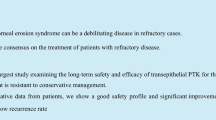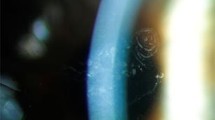Abstract
Background
To evaluate and compare the efficacy of phototherapeutic keratectomy (PTK) for recurrent corneal erosion (RCE) caused by trauma, map-dot-fingerprint dystrophy (MDF) or instances without an established cause.
Methods
Single center prospective longitudinal study. Between January 2003 and November 2006 we treated 89 eyes of 82 patients with PTK. All patients presented with refractory RCE caused either by trauma, MDF or with no established cause. During follow-up (until May 2013), patients, treating ophthalmologists and/or family doctors were interviewed about the patients’ state of health, recurrence of pain, the necessity of further treatments or the occurrence of complications. Five patients died or were lost during follow-up and were thus excluded from the analysis. Freedom of recurrence was estimated using logistic regression analysis using indicator variates for the following three etiologic groups: trauma (55 eyes), MDF (29 eyes) and idiopathic (no established cause; 5 eyes).
Results
Overall 89 eyes of 82 patients were followed-up. Average follow-up among failures and non-failures was 51.56 months (standard deviation (SD) 21.22, range 24 to 91) and 95.25 months (SD 15.99, range 35 to 137 months), respectively. Fifty-seven percent were female and the average age at first PTK was 45.3 years (range: 23 to 70 years). During follow-up, there were 25 recurrences and 15 of these patients received a re-PTK. Compared to patients with a traumatic cause of epithelial erosions, the likelihood of experiencing a recurrence was higher in patients with MDF [odds ratio (OR) 5.48; 95 % confidence interval (CI) 1.93 to 15.59; p = 0.001]; the OR was 8.81 (95 % CI 1.27 to 61.32; p = 0.028) for patients with an idiopathic cause.
Conclusions
In view of the available evidence, we want to raise the awareness of those managing patients with MDF and idiopathic causes that, in order to control the disease, recurrent PTK treatments are expected to be necessary more often than in cases of traumatic RCE.
Similar content being viewed by others
References
Brown N, Bron A (1976) Recurrent erosion of the cornea. Br J Ophthalmol 60:84–96
Waring GO 3rd, Rodrigues MM, Laibson PR (1978) Corneal dystrophies. II. Endothelial dystrophies. Surv Ophthalmol 23:147–168
Aitken DA, Beirouty ZA, Lee WR (1995) Ultrastructural study of the corneal epithelium in the recurrent erosion syndrome. Br J Ophthalmol 79:282–289
Maini R, Loughnan MS (2002) Phototherapeutic keratectomy re-treatment for recurrent corneal erosion syndrome. Br J Ophthalmol 86:270–272
Gartry D, Kerr Muir M, Marshall J (1991) Excimer laser treatment of corneal surface pathology: a laboratory and clinical study. Br J Ophthalmol 75:258–269
Garrana RM, Azar DT (1999) Phakic intraocular lenses for correction of high myopia. Int Ophthalmol Clin 39:45–57
Chen YT, Huang CW, Huang FC, Tseng SY, Tseng SH (2006) The cleavage plane of corneal epithelial adhesion complex in traumatic recurrent corneal erosion. Mol Vis 12:196–204
Tripathi RC, Bron AJ (1972) Ultrastructural study of non-traumatic recurrent corneal erosion. Br J Ophthalmol 56:73–85
Hykin PG, Foss AE, Pavesio C, Dart JK (1994) The natural history and management of recurrent corneal erosion: a prospective randomised trial. Eye (Lond) 8(Pt 1):35–40. doi:10.1038/eye.1994.6
Jain S, Austin DJ (1999) Phototherapeutic keratectomy for treatment of recurrent corneal erosion. J Cataract Refract Surg 25:1610–1614
Dinh R, Rapuano CJ, Cohen EJ, Laibson PR (1999) Recurrence of corneal dystrophy after excimer laser phototherapeutic keratectomy. Ophthalmology 106:1490–1497. doi:10.1016/S0161-6420(99)90441-4
Niesen U, Thomann U, Schipper I (1994) Phototherapeutic keratectomy. Klin Monbl Augenheilkd 205:187–195. doi:10.1055/s-2008-1045515
Fagerholm P (2003) Phototherapeutic keratectomy: 12 years of experience. Acta Ophthalmol Scand 81:19–32
Bernauer W, De Cock R, Dart JK (1996) Phototherapeutic keratectomy in recurrent corneal erosions refractory to other forms of treatment. Eye (Lond) 10(Pt 5):561–564. doi:10.1038/eye.1996.130
O’Brart DP, Muir MG, Marshall J (1994) Phototherapeutic keratectomy for recurrent corneal erosions. Eye (Lond) 8(Pt 4):378–383. doi:10.1038/eye.1994.90
Garrana RM, Zieske JD, Assouline M, Gipson IK (1999) Matrix metalloproteinases in epithelia from human recurrent corneal erosion. Invest Ophthalmol Vis Sci 40:1266–1270
Gipson IK (1992) Adhesive mechanisms of the corneal epithelium. Acta Ophthalmol Suppl: 13–17
Wu WC, Stark WJ, Green WR (1991) Corneal wound healing after 193-nm excimer laser keratectomy. Arch Ophthalmol 109:1426–1432
Lohmann CP, Sachs H, Marshall J, Gabel VP (1996) Excimer laser phototherapeutic keratectomy for recurrent erosions: a clinical study. Ophthalmic Surg Lasers 27:768–772
Morad Y, Haviv D, Zadok D, Krakowsky D, Hefetz L, Nemet P (1998) Excimer laser phototherapeutic keratectomy for recurrent corneal erosion. J Cataract Refract Surg 24:451–455
Seitz B, Langenbucher A, Hafner A, Kus MM, Naumann GO (2002) Phototherapeutic keratectomy for recurrent corneal erosion syndrome (e-PTK). Report on 116 consecutive interventions. Ophthalmologe 99:703–708. doi:10.1007/s00347-001-0595-4
Fagerholm P, Fitzsimmons TD, Orndahl M, Ohman L, Tengroth B (1993) Phototherapeutic keratectomy: long-term results in 166 eyes. Refract Corneal Surg 9:S76–S81
Dausch D, Landesz M, Klein R, Schroder E (1993) Phototherapeutic keratectomy in recurrent corneal epithelial erosion. Refract Corneal Surg 9:419–424
Ohman L, Fagerholm P, Tengroth B (1994) Treatment of recurrent corneal erosions with the excimer laser. Acta Ophthalmol (Copenh) 72:461–463
Pogorelov P, Langenbucher A, Kruse F, Seitz B (2006) Long-term results of phototherapeutic keratectomy for corneal map-dot-fingerprint dystrophy (Cogan-Guerry). Cornea 25:774–777. doi:10.1097/01.ico.0000214801.02195.d4
Cavanaugh TB, Lind DM, Cutarelli PE, Mack RJ, Durrie DS, Hassanein KM, Graham CE (1999) Phototherapeutic keratectomy for recurrent erosion syndrome in anterior basement membrane dystrophy. Ophthalmology 106:971–976. doi:10.1016/S0161-6420(99)00540-0
Laibson PR, Krachmer JH (1975) Familial occurrence of dot (microcystic), map, fingerprint dystrophy of the cornea. Invest Ophthalmol 14:397–399
Baryla J, Pan YI, Hodge WG (2006) Long-term efficacy of phototherapeutic keratectomy on recurrent corneal erosion syndrome. Cornea 25:1150–1152. doi:10.1097/01.ico.0000240093.65637.90
Conflict of Interest Statement
All authors certify that they have no affiliations with or involvement in any organization or entity with any financial interest (such as honoraria; educational grants; participation in speakers’ bureaus; membership, employment, consultancies, stock ownership, or other equity interest; and expert testimony or patent-licensing arrangements) or non-financial interest (such as personal or professional relationships, affiliations, knowledge or beliefs) in the subject matter or materials discussed in this manuscript.
Author information
Authors and Affiliations
Corresponding author
Rights and permissions
About this article
Cite this article
Dedes, W., Faes, L., Schipper, I. et al. Phototherapeutic keratectomy (PTK) for treatment of recurrent corneal erosion: Correlation between etiology and prognosis – prospective longitudinal study. Graefes Arch Clin Exp Ophthalmol 253, 1745–1749 (2015). https://doi.org/10.1007/s00417-015-2990-6
Received:
Revised:
Accepted:
Published:
Issue Date:
DOI: https://doi.org/10.1007/s00417-015-2990-6




